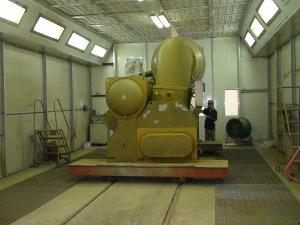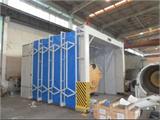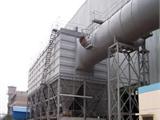Spray painting drying room soso wiki
Summary of Spray-Drying-Paint Room
The spray-drying-paint room is designed by our company, drawing on the wisdom of predecessors and combining with our own innovative ideas. It integrates the functions of a spray booth and a drying room (bake booth) into one unified system. The catalog includes 123456789101112131415.
The spray-drying-paint room operates using top air supply and bottom exhaust. During the spraying process, both the supply fan and the exhaust fan are started simultaneously (if additional heating is required in winter, the heating system will also be activated).
Outdoor fresh air enters through the intake filter for primary purification before being directed to the heating and air supply unit. The processed airflow is then delivered to the static pressure chamber at the top of the spray booth by the supply fan. The filtering cotton at the bottom of the static pressure chamber evenly distributes the airflow while blocking solid dust particles. After filtration, the airflow enters the spray booth at a uniform speed, forming a gentle downward airflow around the workpiece and the operator, preventing paint mist from dispersing outward. This protects the operator's safety. The indoor average empty-load wind speed is between 0.3-0.5 meters/second. Under the influence of ordered airflow, the air containing paint mist passes through the light-duty grid into the exhaust trench. Most of the paint mist settles on the deflector plates due to sudden refraction when it bypasses the trench grid. Remaining fine paint mist particles are further filtered by the paint mist filtration cotton below the deflector plate. The purified airflow is then discharged to the outdoors via an explosion-proof exhaust fan. The efficiency of paint mist purification is ≥95%. During spraying, external air is filtered by a primary filter net before being sent to the roof by the fan, followed by secondary filtration and purification through the top filter net before entering the room. The indoor air uses a full-descending flow method, moving downward at a speed of ≥0.3m/s, ensuring that paint mist particles cannot remain suspended in the air after spraying. These particles are directly expelled outside through the bottom filtration device, maintaining an indoor air cleanliness level above 98% during continuous cycling. The supplied air has a certain pressure, ensuring that indoor dust does not infiltrate the spray-bake booth, thus maximizing the quality of painting.
This equipment mainly consists of the room body, supply and exhaust system, air purification system, lighting device, heating device, exhaust treatment system, three-dimensional workbench, electric flatbed cart, electric door, and electrical control system. This spray-drying booth serves dual purposes: it can be used for both spraying and drying.
◆ This spray-drying booth belongs to a large-scale spray-bake booth. Considering the strength and overall sealing of the room body, the frame structure is made of square tube 80×80×5 welded into an integral framework. The color steel plate 0.5mm thick is used to form the tongue-and-groove EPS sandwich insulation board δ75mm thick. The insulation board is skeleton-free, reducing heat transfer, and finally assembled on-site into a whole.
◆ Both inside and outside of the room body are wrapped with grooved and angular edges, providing decorative appeal and sealing capabilities. Sealing glue is used to ensure no air leakage.
◆ Two parallel standard steel rails are laid on the floor, flush with the ground, for the placement of the electric flatbed cart.
◆ A flammable gas alarm device is installed inside the room body.
◆ An emergency lighting device is installed inside the room body.
◆ No one should stand or place items near the safety door. Storing paint-related items or smoking inside the room is strictly prohibited.
◆ Three return air trenches are set under the floor of the room body. The trenches are covered with movable steel grids, facilitating movement and cleaning by operators. The grid load-bearing capacity exceeds 300kg/㎡.
◆ The frame adopts a lightweight steel structure design, ensuring stable and safe room body; the walls are sealed with composite insulation boards, making them aesthetically pleasing and quick to construct.
◆ A three-dimensional workbench car can be configured inside the spray booth for convenient spraying of various large workpieces from different angles.
◆ The working area complies with labor safety and health standards, and exhaust emissions meet national environmental protection standards.
◆ Safety protection measures are installed inside the spray-drying booth: during drying operations, an exhaust concentration alarm device is set up inside the spray booth. When the exhaust concentration reaches a dangerous level, the exhaust system automatically activates to promptly discharge the exhaust to the outdoors, effectively avoiding hazardous situations. Safe and reliable!
◆ Lighting System for Spray-Drying Booth: Energy-saving explosion-proof lighting with long service life, uniform illumination, ensuring no shadows during work.
◆ Paint Oven Heat Exchanger: Made from high-quality stainless steel scientifically designed and welded, featuring large heat exchange area, high thermal efficiency, energy-saving, and safe reliability. Control System: Self-control system, constant temperature paint baking, automatic shutdown, and other multiple functions.
◆ Supply and Exhaust System: Insulated fans with large airflow, low noise, ensuring uniform airflow velocity in the work area, meeting the highest requirements for spraying.
◆ Multiple heating methods available: electric heating, steam heat exchange, fuel oil heating, gas heating, etc.
◆ The main material of the room body is selected as a composite insulation board with its inner and outer layers made of color-coated hot-dip galvanized steel plates, filled with flame-retardant insulation materials, integrally pressed together with the inner and outer plates. Advantages of composite insulation boards:
◆ Lightweight, novel, and aesthetically pleasing design.
◆ Good strength, stiffness, stability, impact resistance, seismic performance, and corrosion resistance.
◆ Quick construction, waterproof, and long service life.
◆ A static pressure chamber is set at the top of the room body to ensure uniform airflow. The bottom surface of the static pressure chamber is laid with imported Italian filtration cotton, ensuring clean air entering the room body, keeping the product free from contamination.
◆ An electric swing-open gate is set at one end of the room body for easy entry and exit of workpieces.
◆ A safety door is set on the side wall of the room body for personnel access. The safety door is equipped with adjustable pressure locks and opening/closing devices. In case of an accident, it can automatically release pressure, allowing personnel to safely evacuate.
◆ A paint mist filtration layer is laid below the grid, making replacement convenient, with high filtration efficiency and long service life.
◆ Tracks are set close to both sides inside the room body, with a three-dimensional workbench placed on the tracks for convenience of operators.
A spray booth, as the name suggests, refers to a dedicated space where objects are sprayed with paint after passing through a filtration system. Nowadays, these booths are commonly referred to as spray-drying booths. Traditional spraying was done outdoors using a nozzle to apply paint onto tools like cars and furniture. However, this method could lower the quality of painting for larger objects, such as mixing dust from the air with the paint, thereby reducing the quality of the finish. It also led to uncertain waste of paint, left the spraying area very dirty, and exposed workers to significant dirt and inhalation of paint mist, which is harmful to their health. To address these issues, people began to limit the spraying process within a specific range, leading to the creation of the earliest spray-drying booths—exhaust-type spray booths. In China, the first spray booths were developed in the Chengdu region in the 1990s.
### Classification
1) **By Airflow Direction**: There are three types.
- **Crossflow Spray Booth**: Air flows from one end of the booth to the other. This model is cost-effective and easy to install but has drawbacks as the mist moves along the side of the vehicle, and the mist cannot be removed from around the operator's face, resulting in less than ideal working conditions.
- **Side Downflow Spray Booth**: Air enters the booth through the ceiling filtration system and exits through the side wall roots. This mid-range priced booth offers better spray results and working environments since the mist stays away from the object and is removed from around the operator.
- **Full Downflow Spray Booth**: Represents the most advanced technology today. Air enters from the ceiling and exits through underground pits or basements. This exhaust method ensures a cleaner spraying process and safer working environment, albeit at higher costs and requiring more space.
2) **By Heating Method**: Can be divided into diesel spray booths, electrically heated spray booths, steam-heated spray booths, infrared paint booths, waste engine oil spray booths, etc.
3) **By Paint Mist Treatment Method**: Can be classified into dry-type spray booths and wet-type spray booths (water treatment). Dry-type treatment is most commonly used, so the filtration system (mainly referring to primary and secondary filtration cotton) must be regularly checked and replaced to avoid affecting the quality of painting or causing fires. With advancements in science and technology, methods for handling excess paint mist have become increasingly sophisticated. Many high-end vehicles now use water treatment spray booths, dissolving excess paint mist in water, representing significant progress in paint mist treatment.
Key aspects of exhaust-type spray booths include ventilation, filtration of small particles, and exhaust of waste air. The principle involves air (outdoor air) passing through the spray booth door filter cloth, the spray table, utilizing spray equipment for application, and finally being expelled by exhaust fans (removing generated paint mist).
Weaknesses of this type of spray-drying booth still exist:
1. Filter cloth is easily damaged, allowing dust to enter.
2. Likely to introduce unclean outdoor air.
3. Requires frequent cleaning and regular removal of dirt from the filter cloth.
Recently, a new type of spray booth—the fully pressurized spray booth—has emerged and is widely applied in China's furniture industry. Its basic principle is similar to the exhaust-type spray booth, but it utilizes the directivity of pressure, applying vertical spraying from top to bottom for greater accuracy. Additionally, hardware improvements include a main machine room, replacing filter cloth with "multi-layer filtration cotton" for higher air cleanliness, using infrared lamps to save drying time, and employing water curtains for more environmentally friendly disposal of excess paint mist. As a result, rework rates are nearly zero, paint consumption is reduced, and work efficiency is improved. Due to the use of infrared lamps, this is also called a paint oven.
In the context of numerous global automotive markets experiencing consecutive losses, the Chinese automotive market stands out, achieving remarkable results. This provides a large stage for the development of China's auto maintenance market. Over the past decade, despite fluctuations and accelerations, all individuals, enterprises, and the Chinese auto maintenance market remain highly enthusiastic and confident. With the continuous increase in domestic automobile totals, the demand for spray booths continues to grow, particularly for large, irregular spray booths. High-quality, specialized paint ovens are taking up an increasingly larger share of the market.
The principle and structure of the spray booth involve the entire spray-drying booth being modularly constructed, with the room body using plug-in insulated spray-plastic wall panels, offering good sealing and insulation performance. The aluminum-framed doors have observation windows for real-time monitoring of internal dynamics. The room body is equipped with work doors on the side for easy access by staff. A high-quality stainless steel heat exchanger ensures high efficiency and longevity. Imported, low-noise, high-volume fans ensure perfect spray effects.
The spray booth provides the following for workpiece spraying:
(1) A clean working environment;
(2) Efficient collection of paint mist.
The configuration of the spray booth varies based on the size, shape, weight, and production guidelines of the workpieces. There are open and closed types, continuous and intermittent types, rotating or fixed workpieces, single-sided or double-sided spraying options. Recently, developments include oil curtain spray booths and bottom spray booths. Structurally, it should include a supply air filtration system, workpiece hanging (conveyance, rotation) device, water curtain system, water washing system, exhaust system, water tank, lighting device, and room body. Paint mist recovery is divided into two parts:
1. During spraying, paint mist collides with the water curtain, part of which dissolves and falls into the water tank.
2. Un-dissolved paint mist enters the water wash room through gaps at the bottom of the water curtain plate, thoroughly mixes with the water mist sprayed by fogging nozzles, undergoes gas-water separation, and then sinks into the water tank. A paint mist coagulant is added periodically in the water tank to form paint sludge.
Factors to consider when purchasing a paint oven:
① Brightness: The brightness inside the paint oven needs to reach 800-1000 lux, using lights close to D65 source, and the walls should be matte white.
② Airflow rate.
③ Filtration effect: This depends on the model of the top cotton in the paint oven. Commonly used models in repair shops are EU5 and EU6. During use, a sun lamp can be shone upwards inside the oven, with fewer than 5 extremely fine dust particles per square meter.
④ Wall sealing effect: The paint oven must be sealed, and there should be no accumulation of paint dust at the seams.
⑤ Positive pressure assurance: The air intake volume should slightly exceed the exhaust volume to keep the paint oven positively pressurized.
⑥ Sealing effect of the heating system: Around the burner and chimney, good sealing should prevent the accumulation of combustion ash.
⑦ Heating speed: The time taken for the paint oven to rise from 20°C to 60°C is approximately 10-15 minutes. Note that some paint ovens may have inaccurate thermometers, so the temperature measurement should be based on the metal body inside the paint oven. If the selected paint oven meets the above conditions, it can be considered an ideal choice.
Over time, issues such as poor quality, excessive dust, poor construction effects, and inadequate lighting may arise. Proper use and maintenance of the paint oven can completely avoid these problems. Below are some simple tips on the use and daily maintenance of automobile paint ovens to reduce unnecessary wear and lower safety hazards.
1. Determine a reasonable configuration form.
2. Set a reasonable average horizontal airflow speed for the spray booth.
3. Reasonably match the supply and exhaust systems to ensure slight positive pressure inside the spray booth.
4. Ensure uniform water curtain thickness, paying attention to the structure of the upper water tank and the distribution of the water supply pipeline.
5. Maintain a reasonable distance between the bottom of the water curtain plate and the water level in the water tank.
6. Make the water mist spray nozzles and pipelines easy to disassemble, replace, and clean.
7. Ensure adequate gas-water separation and sedimentation for easy cleaning.
References:
1.
2.
3. Guangdong Province "Air Pollution Emission Limit" (DB44/27-2001)
4. "Machinery Equipment Installation Construction and Acceptance Specification" (TJ231-28)
5. "Industrial Pipeline Engineering Construction and Acceptance Specification" (GBJ235-82)
6. "Low Voltage Power Distribution Equipment and Circuit Design Specification" (GBJ54-83)
Spray booths are generally used for spraying and baking paint, hence the term "spray-bake booth" is more accurate. They are widely used in industries such as automobiles, machinery, hardware, furniture, and chemicals for surface spraying and baking of workpieces. Based on the airflow direction, spray booths can be classified into crossflow, side downflow, and full downflow types. Each type has its advantages and disadvantages in terms of cost, installation, spray effect, and working environment.
Environmental spray booths solve existing problems of harsh working environments, improving product quality and reducing harm to workers' health and the environment. Features include high efficiency, environmental friendliness, and energy savings. External air is filtered through a primary filter net, then passed through a secondary filter at the top before entering the room. Using full-descending airflow at a speed ≥0.3m/s ensures that paint mist particles cannot remain suspended in the air after spraying, directly exiting through the bottom filtration device. Continuous cycling maintains indoor air cleanliness above 98%, with the supplied air having a certain pressure to prevent dust infiltration, ensuring maximum spray quality. During baking, adjusting the air damper to the baking position allows hot air circulation, rapidly raising the room temperature to the preset drying temperature (≤80°C). Fresh external air is initially filtered, exchanges heat with the heat converter, and enters the air chamber at the top of the paint booth, undergoing secondary filtration. Through internal recirculation, most of the hot air is reused, except for a small amount of fresh air intake, continuously heating to raise the temperature inside the paint booth. When the temperature reaches the set value, the burner automatically stops; when the temperature drops, the fan and burner restart, maintaining a relatively constant temperature inside the paint booth. Finally, when the baking time reaches the set duration, the paint booth automatically shuts off, completing the baking process.
Operational precautions:
1. Before spraying, check if the air pressure is normal and ensure the filtration system is clean.
2. Check the air compressor and oil-water micro-dust separator to keep the spray hose clean.
3. Store spray guns, spray hoses, and paint mixing cans in clean areas.
4. All pre-spraying processes except blowing and wiping with sticky cloths should be completed outside the paint booth.
5. Only perform spraying and baking inside the spray booth, and only open the door when vehicles enter or exit. When opening the door, activate the air circulation system to create positive pressure and prevent external dust from entering.
6. Personnel must wear designated spray suits and safety protective equipment when operating inside the paint booth.
7. Remove flammable items from the paint booth during baking operations.
8. Non-essential personnel should not enter the paint booth.
Maintenance:
1. Clean the walls, glass, and base every day to prevent dust and paint dust accumulation.
2. Clean the intake dust filter weekly, check the exhaust dust filter for blockage, and replace it if the indoor air pressure increases without cause.
3. Replace the floor dust fiber cotton every 150 hours of operation.
4. Replace the intake dust filter every 300 hours of operation.
5. Clean the floor water tray monthly and wash the diesel filter on the burner.
6. Check the transmission belts of the intake and exhaust motors quarterly.
7. Clean the entire paint booth and floor grid every six months, inspect the circulation air valve, intake and exhaust fan bearings, check the smoke channel of the burner, clean the sediment in the oil tank, clean the water-based protective film of the spray booth, and reapply it.
8. Clean the entire heat exchanger annually, including the combustion chamber and smoke channel, and replace the top cotton of the paint booth every year or every 1200 hours of operation.
Selecting and planning the paint booth appropriately not only maximizes the requirement for high-level spraying but also ensures a safe, healthy, bright, and comfortable working environment for the painters. Domestic spray booths come in various price ranges, from low to medium at 20,000-60,000 RMB, high-end at 60,000-150,000 RMB, and large-scale ones at 150,000-400,000 or 500,000 RMB. Product varieties are abundant, mostly non-standard. Common types include integrated spray-drying booths, fuel-type high-temperature paint booths, electric-powered paint booths, natural gas paint booths, eco-friendly paint booths, retractable mobile paint booths, pump-less water curtain paint booths, infrared paint booths, and standard paint booths, each with different functionalities




